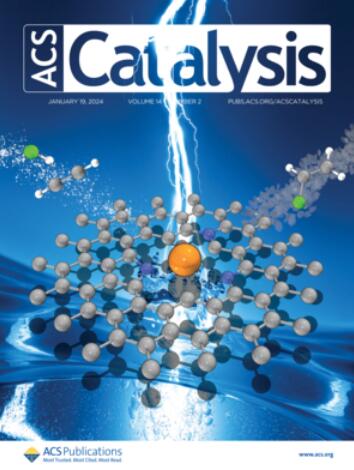Rh-Based Bimetallic Alloys: Unraveling the Synergistic Catalysis in CO2 Hydrogenation to Ethanol
IF 13.1
1区 化学
Q1 CHEMISTRY, PHYSICAL
引用次数: 0
Abstract
The utilization of Rh-based catalysts in the direct production of ethanol from CO2 has been a subject of significant interest. However, to date, the precise active sites responsible for ethanol generation and the C–C coupling mechanism remain elusive. In this study, we present a Rh-based catalyst featuring nanoscale Rh–Fe alloy sites, which achieved an ethanol selectivity of 49.1% among all hydrocarbon and oxygenate products (CO excluded) under relatively mild reaction conditions (3.0 MPa, 200 °C, with a low metal loading of ≤1 wt %). The formation of ethanol proceeds via the HCOO* pathway with a CO insertion mechanism occurring at the alloy sites with a specific cluster size, where CH2* and CO* act as the crucial intermediates for C–C coupling. The electron interaction within the Rh–Fe alloy sites effectively reduces the energy barrier for the formation of the CH2CO* intermediate, thereby facilitating the production of ethanol. In contrast to the Rh–Fe alloy sites, the geminal-dicarbonyl binding configuration of CO* intermediates on Rh single sites favors the generation of byproducts such as methane and methanol, rather than ethanol. This research offers insights into the active sites and reaction mechanism of hydrogenation of CO2 to ethanol, thus enhancing the efficient utilization of Rh-based catalysts.

rh基双金属合金:揭示CO2加氢制乙醇的协同催化作用
利用rh基催化剂直接从二氧化碳中生产乙醇一直是一个重要的兴趣课题。然而,迄今为止,负责乙醇生成的确切活性位点和C-C偶联机制仍然难以捉摸。在这项研究中,我们提出了一种具有纳米级Rh-Fe合金位点的rh基催化剂,在相对温和的反应条件下(3.0 MPa, 200°C,低金属负载≤1wt %),对所有碳氢化合物和含氧产物(CO除外)的乙醇选择性为49.1%。乙醇的形成通过HCOO*途径进行,CO插入机制发生在具有特定簇大小的合金位点,其中CH2*和CO*是C-C偶联的关键中间体。Rh-Fe合金位内的电子相互作用有效地降低了CH2CO*中间体形成的能垒,从而促进了乙醇的生成。与Rh - fe合金位点相比,Rh单位点上CO*中间体的二元二羰基结合构型有利于生成甲烷和甲醇等副产物,而不是乙醇。本研究揭示了CO2加氢制乙醇的活性位点和反应机理,从而提高了rh基催化剂的高效利用。
本文章由计算机程序翻译,如有差异,请以英文原文为准。
求助全文
约1分钟内获得全文
求助全文
来源期刊

ACS Catalysis
CHEMISTRY, PHYSICAL-
CiteScore
20.80
自引率
6.20%
发文量
1253
审稿时长
1.5 months
期刊介绍:
ACS Catalysis is an esteemed journal that publishes original research in the fields of heterogeneous catalysis, molecular catalysis, and biocatalysis. It offers broad coverage across diverse areas such as life sciences, organometallics and synthesis, photochemistry and electrochemistry, drug discovery and synthesis, materials science, environmental protection, polymer discovery and synthesis, and energy and fuels.
The scope of the journal is to showcase innovative work in various aspects of catalysis. This includes new reactions and novel synthetic approaches utilizing known catalysts, the discovery or modification of new catalysts, elucidation of catalytic mechanisms through cutting-edge investigations, practical enhancements of existing processes, as well as conceptual advances in the field. Contributions to ACS Catalysis can encompass both experimental and theoretical research focused on catalytic molecules, macromolecules, and materials that exhibit catalytic turnover.
 求助内容:
求助内容: 应助结果提醒方式:
应助结果提醒方式:


